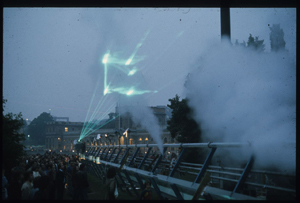February 01, 2011
 This year MIT celebrates its 150th year with an impressive and fascinating exhibition of 150 historic inventions in the MIT Museums new Thomas Peterson Gallery curated by Deborah Douglas.
This year MIT celebrates its 150th year with an impressive and fascinating exhibition of 150 historic inventions in the MIT Museums new Thomas Peterson Gallery curated by Deborah Douglas.
Among these fundamental breakthrough inventions shown is "Centerbeam," a kinetic performing group work exhibited at documenta 6 in Kessel, Germany (1977) and on the National Mall in Washington, D.C. (1978). Lowry Burgess, professor of art and former dean of the College of Fine Arts, was the concept originator and artistic director of this monumental work that included laser-projected images on moving steam screens, solar-tracked holograms, a 144-foot water prism and helium-lifted sky sculptures, and interactive sound and video artworks, neon and strobe light art. Its production involved the participation of 22 artists at MIT's Center for Advanced Visual Studies — as well as science and engineering consultants.
On exhibit is an actual section of the 200-foot-long "Centerbeam" along with video, illustrations, essays, and biographical profiles and interviews with the contributors, providing a history of the work, documenting the unusual collaborative process that brought it into being. It was estimated by the park services in both Germany and in Washington that "Centerbeam" was seen by more that a million people in both park settings. It was shown on 24 national television networks.
In 1989 Burgess came to Carnegie Mellon as Dean of the College of Fine Arts. Among his many innovations he founded the STUDIO for Creative Inquiry with Professor Bryan Rogers, head of the School of Art and a former colleague of Burgess at MIT, based on the model of the Center for Advanced Visual Studies at MIT founded in 1968 by György Kepes.
Since 1989, the STUDIO for Creative Inquiry has initiated 300 interdisciplinary arts projects involving all the disciplines of the College of Fine Arts with nearly all the departments, centers and colleges of Carnegie Mellon as well as outside participating institutions. The STUDIO supports atypical, interdisciplinary, and inter-institutional research and educational projects at the intersections of arts, technology and culture.
Seth Riskin, now the Manager of Holography and Spatial Imaging and Emerging Technologies Initiatives at MIT and one of the curators of the exhibition was one of the first artists to be in residence at CMU's STUDIO for Creative Inquiry.
The exhibition will run through December 31, 2011. For more information on the "Centerbeam" project visit http://museum.mit.edu/150/89.
News Brief: Visual Experience
Lowry Burgess's Historic Artwork "Centerbeam" is on Display at the MIT Museum
 This year MIT celebrates its 150th year with an impressive and fascinating exhibition of 150 historic inventions in the MIT Museums new Thomas Peterson Gallery curated by Deborah Douglas.
This year MIT celebrates its 150th year with an impressive and fascinating exhibition of 150 historic inventions in the MIT Museums new Thomas Peterson Gallery curated by Deborah Douglas.Among these fundamental breakthrough inventions shown is "Centerbeam," a kinetic performing group work exhibited at documenta 6 in Kessel, Germany (1977) and on the National Mall in Washington, D.C. (1978). Lowry Burgess, professor of art and former dean of the College of Fine Arts, was the concept originator and artistic director of this monumental work that included laser-projected images on moving steam screens, solar-tracked holograms, a 144-foot water prism and helium-lifted sky sculptures, and interactive sound and video artworks, neon and strobe light art. Its production involved the participation of 22 artists at MIT's Center for Advanced Visual Studies — as well as science and engineering consultants.
On exhibit is an actual section of the 200-foot-long "Centerbeam" along with video, illustrations, essays, and biographical profiles and interviews with the contributors, providing a history of the work, documenting the unusual collaborative process that brought it into being. It was estimated by the park services in both Germany and in Washington that "Centerbeam" was seen by more that a million people in both park settings. It was shown on 24 national television networks.
In 1989 Burgess came to Carnegie Mellon as Dean of the College of Fine Arts. Among his many innovations he founded the STUDIO for Creative Inquiry with Professor Bryan Rogers, head of the School of Art and a former colleague of Burgess at MIT, based on the model of the Center for Advanced Visual Studies at MIT founded in 1968 by György Kepes.
Since 1989, the STUDIO for Creative Inquiry has initiated 300 interdisciplinary arts projects involving all the disciplines of the College of Fine Arts with nearly all the departments, centers and colleges of Carnegie Mellon as well as outside participating institutions. The STUDIO supports atypical, interdisciplinary, and inter-institutional research and educational projects at the intersections of arts, technology and culture.
Seth Riskin, now the Manager of Holography and Spatial Imaging and Emerging Technologies Initiatives at MIT and one of the curators of the exhibition was one of the first artists to be in residence at CMU's STUDIO for Creative Inquiry.
The exhibition will run through December 31, 2011. For more information on the "Centerbeam" project visit http://museum.mit.edu/150/89.